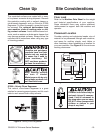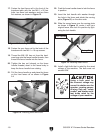
G0555X 14" Extreme Series Bandsaw
-17-
Figure 16. Dust hose attached to dust port.
"Blade Tracking" is how the blade rides on the
wheels. When tracking correctly, the blade rides
in the center of both wheels.
Blade tracking is primarily controlled by adjust-
ing the upper wheel tilt. Tracking the blade in
this manner is referred to as "Center Tracking,"
because you tilt the wheel until the blade rides in
the center.
Another way to track the blade is known as
"Coplanar Tracking." Coplanar tracking involves
aligning the wheels so they are parallel and
aligned. (See Wheel Alignment
on Page 41.)
When wheels are coplanar, the bandsaw decreas
-
es vibration and heat.
The wheels on the Model G0555X are factory
aligned, so center tracking is the only adjustment
that needs to be performed
To center track the blade:
1. DISCONNECT BANDSAW FROM POWER!
2. Adjust the upper/lower guide bearings and
support bearings away from the blade.
3. Open the upper wheel cover.
4. Adjust the blade tension to match the size
of the installed blade with the mark on the
blade tension scale located on the back of
the bandsaw.
5. Spin the upper wheel by hand at least three
times and watch how the blade rides on the
crown of the wheel. Refer to
Figure 17 for an
illustration of this concept.
—If the blade rides in the center of the
upper wheel and is centered on the peak
of the wheel crown, then the bandsaw is
already tracked properly and no additional
adjustments are needed. Skip to Step 9
.
—If the blade does not ride in the center
of the upper wheel and is not centered
on the peak of the wheel crown, then
continue with the next step.
Blade Tracking
To connect a dust collection hose:
1. Fit the 4" dust hose over the dust port, as
shown in
Figure 16, and secure in place with
a hose clamp
.
2. Tug the hose to make sure it does not come
off.
Note: A tight fit is necessary for proper per-
formance.
Only operate the Model G0555X with an
adequate dust collection system. This saw
creates substantial amounts of fine wood
dust while operating. Failure to use a dust
collection system can result in respiratory
illness.
Dust Collection
Recommended CFM at Dust Port: 400 CFM
Do not confuse this CFM recommendation with
the rating of the dust collector. To determine
the CFM at the dust port, you must consider
these variables: (1) CFM rating of the dust col
-
lector, (2) hose type and length between the
dust collector and the machine, (3) number
of branches or wyes, and (4) amount of other
open lines throughout the system. Explaining
how to calculate these variables is beyond the
scope of this manual. Consult an expert or pur-
chase a good dust collection "how-to" book.


















